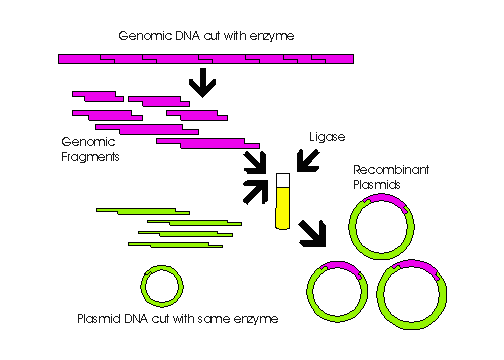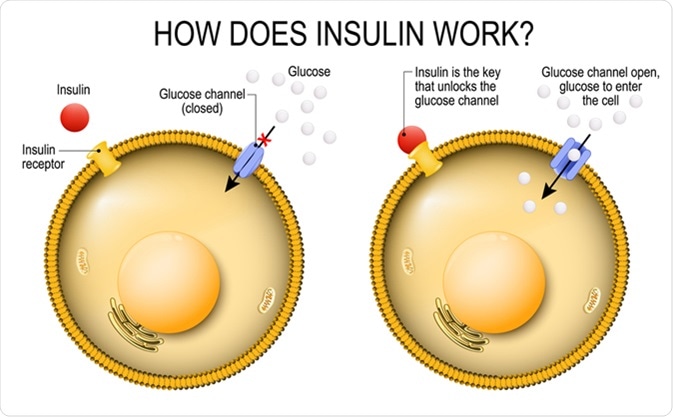Describe How Bacteria Are Used to Produce Insulin.
Another usage of bacteria and other microorganisms is a relatively new field of using Recombinant DNA in bacteria to produce Insulin and other hormones or. How is genetic engineering used to create bacteria capable of producing human insulin.

Do You Know How Can Bacteria Be Genetically Engineered To Produce A Human Protein Adipose Tissue Genetics Growth Hormone
The bacteria produce the insulin and simply excrete it into solution.

. Insulin helps the body break down fats carbohydrates and proteins from food to be used for energy. In the production of human insulin by bacteria what may be the role of bacteria. Start studying Steps used to produce insulin using recombinant DNA and bacteria.
The human insulin gene is inserted into each plasmid. Synthetic human insulin was the first golden molecule of the biotech industry and the direct result of recombinant DNA technology. Start your trial now.
Because recombinant insulin is identical to human insulin it does not cause an immune reaction in people who take it. Learn vocabulary terms and more with flashcards games and other study tools. There the recombinant bacteria use the gene to begin producing human insulin.
A plasmid DNA is extracted from a bacterium and cut with restriction enzyme forming plasmid vector. Researchers return the plasmid to the bacteria and. 3 e An industrial fermenter is used to grow the genetically modified bacteria.
When the plasmid was placed into the E. Add sticky ends to insulin gene and to plasmid. Coli to produce insulin.
RDNA technology is one of the most advanced techniques of molecular genetics View the full answer. Also necessary to synthesize insulin are large tanks to grow the bacteria and nutrients are needed for the bacteria to grow. Bacteria are genetically engineered to produce human insulin using recombinant DNA technology.
Cut out insulin gene cut open plasmid with restriction enzyme. Insert the human insulin gene into the plasmid. There the recombinant bacteria use the gene to begin producing human insulin.
Restriction enzyme to cut open plasmid. Insert human insulin-producing gene into the bacterial plasmid vector to form the recombinant DNA of human insulin-producing gene. Insulin resistance develops when cells in your muscles fat and liver are unable to use insulin properly resulting in high blood sugar.
The recombinant bacteria then use the gene to start processing human insulin. First week only 499. The plasmid is returned to the bacteria and the recombinant bacteria are placed in large fermentation tanks.
Describe how these bacteria are genetically modified to produce human insulin. Recombinant DNA and Insulin Production. This allowed for the bacteria to actually replicate the plasmid and code for the protein human insulin.
Purify the substance for use as a medicine for people. In the laboratory scientists build the human insulin gene. Bacterial cells are made to take up the genetically.
Synthetic insulin is made in both bacteria and yeast. Then they take a plasmid which is a loop of bacterial DNA and insert the human insulin gene into it. Use m-RNA reverse transcriptase to produce gene c-DNA.
The high cost of extraction and purification has meant that only high value products have been produced at an industrial scale. These pieces are then analyzed and the DNA needed to make the protein is extracted and purified. D The insulin now used for injections is obtained from bacteria that have been genetically modified.
Scientists harvest the insulin from the bacteria and. Recombinant DNA or rDNA is DNA which specifically encodes a protein. The bacterial plasmid containing the insulin gene is placed into a bacterial cell.
Through this model the bacteria continually make new plasmids containing insulin-coding genes that increase the efficiency of an already efficient method for manufacturing insulin. Several instruments are necessary to separate and purify the DNA such as a centrifuge along with various chromatography and x-ray. Coli can be used as vectors to produce human insulin.
Purify the substance for use as a medicine for people. Currently millions of diabetics worldwide use synthetic insulin to regulate their blood sugar levels. Coli the bacteria took up the plasmid.
The bacteria can produce recombinant insulin in large amounts. Generally the bacteria are grown to a large volume before the gene encoding the protein is activated. The plasmid acts as a vector - it is used to transfer DNA from one organism to another.
In the late 1970s scientists began using E. Main stage Insulin example Desired gene is identified Human insulin gene is identified The gene is removed from the organisms DNA The gene for making human insulin is cut out of some human DNA The DNA in other organism is cut open A loop of bacterial DNA is cut open The gene is inserted into the cut DNA The human insulin gene is inserted into the cut. Use same restriction enzyme on second DNA.
The bacterial cell is placed in a fermenter to allow reproduction under perfect conditions warmth moisture and. In the first step of this technology scientists find and separate out the gene that codes for. Put the recombinant bacteria in large fermentation tanks.
Human insulin is extracted from pancreas cells and an insulin-producing gene is isolated. Inside bacteria tiny rings of genes called plasmids determine what substances the bacteria will produce. By splicing in the chemical sequence of human insulin and then inserting this modified plasmid into an Ecoli bacteria scientists created a tiny insulin factory one that multiplied when fed creating many more of these factories until a veritable river of.
This is cut from genomic DNA by a restriction enzyme which cuts DNA at specific sequences along the chain. Recombinant dna technologyblood sugar levelshuman insulinbiotech. Since insulin contains two polypeptide chains linked by.
Reference to complementary sticky ends. The bacteria are then harvested and the desired protein purified from them. The insulin gene is.
Insulin production is part of an endocrine process in the liver that controls blood sugar. Scientists harvest the insulin from the bacteria and. It floats freely in the liquid bath with the bacteria and its recovered by what is essentially a series of calibrated filtration steps to separate pure insulin from the rest of the materials in the reactor.
Describe how bacteria can be made to produce human insulin and Differentiate type 1 and type 2 enzymes. What role does bacteria play in insulin production. View other online activities in.
The majority of the industrial products from. Solution for Describe how bacteria can be made to produce human insulin and Differentiate type 1 and type 2 enzymes.

Pin On Science Is Magic That Works

5 Making Insulin In Bacteria Labxchange

Recombinant Dna And Insulin Production

3dprintingvideosusefultechnology 3dprintingvideosartgalleries

The Hormone Insulin Induces The Reception Of Glucose Into The Cells By Download Scientific Diagram

Ks4 Aqa Gcse Biology Science Genetic Engineering Lesson Activities Teaching Resources Biology Genetic Engineering Engineering Activities
How Is Human Insulin Produced Quora

How Is Recombinant Insulin Made Steps In The Production Of Recombinant Insulin Or Humulin
How Is Human Insulin Produced Quora

Human Insulin Is Being Commercially Produced From A Transgenic Species Of

Write The Steps In The Production Of Human Insulin By Genetic Engineering Method

Insulin From Bacteria To You Youtube

Insulin And Glucose Release Regulation Educational Scheme Outline Concept Stock Illustration Download Image Now Istock

Pdf Cloning Of Human Insulin Gene In Bacterial Expression System
Why Is E Coli Used To Produce Human Insulin Which Characteristic Of It Is Useful Here Quora

Production Of Human Insulin In Bacteria 2016 Ib Biology Youtube


